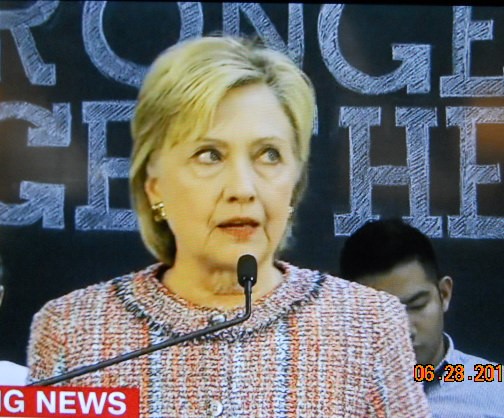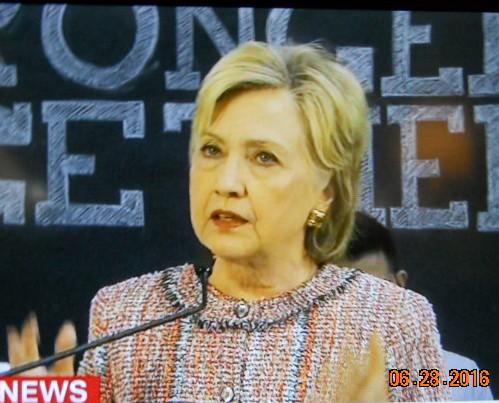This video is slightly longer and ends with Hillary's brief statement on the release of the Republican Benghazi Committee Report.
Hillary Clinton Tours Galvanize in Denver
Following a tour on Tuesday at Galvanize—a tech workforce training facility and community for businesses in Denver—Hillary Clinton unveiled a comprehensive technology and innovation agenda to build an economy that works for everyone, not just those at the top. As part of an ongoing conversation to create more jobs and build a stronger economy that helps us grow together, Clinton highlighted three specific goals to realize these visions:
1) Help young people become entrepreneurs by letting them defer their federal student loans for up to three years; 2) Provide every student in America access to computer science education before graduation; and 3) Connect every household in the U.S. to high-speed internet service by 2020.
Pointing to Donald Trump’s lack of a real job creation strategy and steady vision for the economy, Clinton said, “I want America to get back in the future business. Saying that you want to make America ‘great again’ is code for saying, we want to go back to the way it used to be, forget about technology, forget about inclusivity, forget about giving everybody an opportunity to have a real shot at the best possible future. Well, that is not who we are as Americans; we don’t go back, we go forward, but we’ve got to go forward with intelligence and a real sense of purpose.”
Clinton will also travel to Los Angeles on Tuesday to participate in a live town hall with 100 online content creators and digital influencers. The moderated Q&A session will allow Clinton to address issues important to these influencers’ online audiences—and emphasize her plan to promote young entrepreneurs.
Below is a transcript of Clinton’s remarks in Denver today:
“Thank you, thank you. Well, first let me say, I am blown away and really happy to be here, and I wish each and every one of you the very best as you become not only galvanizers, but entrepreneurs, and innovators, and business leaders in every way.
I want to thank Jim for letting me come and visit one of these campuses of Galvanize. I really am taken by the model, and want to do everything I can to lift it up and create more pathways for more people to have these opportunities. I want to thank Stephanie, who came from Governor Hickenlooper’s staff to be part of this. And I had a chance to visit with the governor earlier, and was talking about the workforce planning that is going on here in Colorado. It’s a real model for the rest of the country creating all of these pathways to give people the skills that are needed in the 21st century economy.
Julie Anne Lerner, thank you very much for the exciting work that Pan Exchange is doing. I know just a little bit about commodities – and their trading, their buying, their selling – both futures and the actual commodities themselves. And what you are doing, Julie, is just transformational, because for most of the world, the agricultural workers are women. More than 60 percent of the farmers in the world are women who farm small plots and who do not have access to information.
Very often, until cellphones came with SMS still, to get some kind of weather reports, they didn’t even know what the weather would be – couldn’t plan. They don’t have access to good seed or pesticides by and large, and what we’re doing through this kind of effort is opening up markets, creating more transparency which will benefit so many of the people who are actually doing the hard work of producing food and trying to get it to market, and create a better life for themselves, their families, and their communities. So, I’m thrilled by that.
And I want to thank Josh Anderson, CEO of Patriot Boot Camp, for working on another set of challenges, and that is how we do a much, much better job creating employment pathways for our vets – something that I have spent a lot of time thinking about and working on. There are good ideas out there, but they’re not yet broad enough, deep enough, so that we are really doing what we should to give our vets the chance to have a good future. It needs to start as – I was just talking to Josh and Ben about – it needs to start while they’re still in the military, before they leave. We don’t do a good enough job with transition planning. And then we’ve got to do more to get them connected with successful programs that produce results as opposed to being scammed, which happens too often at the programs that they are looking at, or enticed into being part of, without really any employment at the end of it.
So, using Patriot Boot Camp as an example, and giving the results that you’ve had, gives me a lot of hope that we can do a much better job for our vets. And that’s something that I am 100 percent committed to. I am so excited about being here.
Now, I do plead guilty to being a policy wonk, and I know that can be boring, and I know that putting out plans can sometimes seem less than inspirational, but it really matters what we do and how we do it, if we’re going to create the economy of the future. And it matters to me to find examples – like here at Galvanize – that we can lift up and try to take to scale. I was delighted to learn that there will soon be a Galvanize in New York, and that we will have the benefit of that.
So I am on a mission to find out what works – not what we hope will work, because we’ll get to that – but what works right now, and how we do more of it, and how we create a lot more of this kind of model, because what we’ve been doing is not sufficient. It doesn’t really produce the results we want for the vast majority of young Americans, or even mid-career Americans coming out of the military, changing jobs in the civilian workplace. So this is part of a pioneering community, and you all are part of that, and I am thrilled to see what you’re accomplishing.
I know across Colorado, you have made smart investments in technology and innovation that’s helping to create a lot of good-paying jobs. It’s not an accident that Denver, and Colorado in general, have a lower than average unemployment rate, because there are opportunities here, there are magnets of jobs and futures that people are drawn by, and we’re going to continue to build on that. I learned that nearly a quarter of the people in and around Denver and Colorado Springs now work in STEM fields. So that is what we are trying to help create elsewhere. The rest of the country could learn a lot about what’s working here.
I want America to get back in the future business. Saying that you want to make America ‘great again’ is code for saying, ‘We want to go back to the way it used to be, forget about technology, forget about inclusivity, forget about giving everybody an opportunity to have a real shot at the best possible future.’ Well, that is not who we are as Americans; we don’t go back, we go forward, but we’ve got to go forward with intelligence and a real sense of purpose.
So my goal is, we build an economy that works for everyone, not just those at the top, and that’s why today, I am releasing a comprehensive plan to keep America on the cutting edge of technology and innovation. It is one of our biggest assets, and I want it to be democratized. I want more people in more places to feel that their future lies in STEM, in technology, in helping to create the jobs that we’re going to attract.
So first, let’s make it easier for young people to become entrepreneurs – exactly what’s going on here at Galvanize. I’ve talked to a lot of people in the field, and starting out can be daunting. There’s a lot of risk, even if you’ve got a good idea – how you translate that into a business, how you grow that business, how you make a living from it. It can be a lot harder if you’re juggling student loan payments, and that can cut into what you’re able to do, what kind of risk you think you can take.
So we’re going to help people with student loans refinance their loans to lower rates, and then we’re going to let young people who want to start something new defer your federal student loan payments for up to three years, so you won’t pay a dime on whatever loans you have for three years. And we want to go even further, so if you get that enterprise up and going, we want to forgive a portion of your debt because you’ve become a job creator, and we need more job creators, and we need more young people starting business, startups, and other kinds of opportunities. So the burden of student debt is not only an individual burden that affects your life choices, it’s an economic burden. $1.2 trillion in student debt – think of how more productive that money could be spent. So this is going to be one of our priorities.
Second, we have to make sure every student in America – no matter what ZIP code that student lives in – gets the chance to learn computer science before they graduate from high school. Those are skills you know so well – you’re here at Galvanize – that will help you compete and succeed in the global economy.
When I used to visit schools as First Lady of Arkansas, First Lady of the United States – a long time ago – I would have what I called ‘the Chelsea test.’ In other words, would I send Chelsea to this school? And some were a resounding ‘yes’ – the creativity, the energy, the collaboration – and some were absolutely not, and no child should go to these schools.
So now, I’m a grandmother, so I have the Charlotte and Aidan test. Would I send these precious grandchildren to any of these schools that I visit? There is such a divide, it’s heartbreaking. Some of you may have had schools where you really got exposed to technology, where you had a chance to both learn on your own and be guided in your learning, but I bet a lot of you didn’t. We can no longer tolerate that. Part of what we have to do, though, is make sure that the benefits of technology and the internet are widely shared. It’s hard to believe, but we still have lots of parts of our country – rural and urban – where you do not have access to high-speed internet. In fact, it’s spotty and it is a economic impediment.
I’ve traveled a lot around our country and you can see what it means not to be connected with the global economy. And I’m thrilled whenever I see places that are historically left out finding ways to get in. So in eastern Kentucky earlier this year, I learned about a successful program that trains former coalminers to be computer programmers, but the lack of affordable, high-speed broadband is a real barrier. So I intend to make sure we do what we did with electricity in my grandparents’ generation – we connect every home and business in America to high-speed internet, and we do it on as fast a timescale as possible, no later than the early 2020s because every year we waste means we leave people behind and left out in a way that is heartbreaking and wrong.
Now, I really believe part of what this election will turn on is how we’re going to create more good jobs with rising incomes, and there’s a lot of legitimate anxiety, fear and even anger in many parts of our country, because people feel like the economy has failed them – they haven’t recovered from the Great Recession; government has failed them – because they haven’t been a good partner in helping people find their footing in going forward. So I think this is going to be one of the defining issues in this election, and I’m going to keep talking about what we can do together – a positive vision that, if we do it, will give so many more people life yourselves a chance to be galvanizers. And I’m going to talk about why we need to get back into the future business, because that’s who we are as Americans. I don’t think we’re people who look backwards. We should be looking forward. And we’re going to focus on what will make the American economy work for everyone, not just those at the top.
So coming here today is a real treat for me because it’s exactly what I want to see everywhere, and it is something that I also want to be sure is available to every American, and somehow we’re going to have to work to make that so, and that has to start in schools, and it has to start with people believing that every kid can be a part of the future – not just some of us, but every single one of us.
So thank you for really being part of this future that we have to create. It is something that I care deeply about, and I wish you all well. I think it’s great you are here being not only interested in your own future, but helping to build a learning community for technology, as the sign says. And I look forward, Jim, to keep hearing more about what you’re doing, why it works, and what more we can do to help you. I’ve already gotten some good ideas from the folks I’ve talked to today about what more we can do to make this work for more people, but let me have a chance to just shake some hands and greet you all, as many as I can before I have to leave. But again, it’s a thrill to be here and I wish you all the very best. Thank you very much.”





